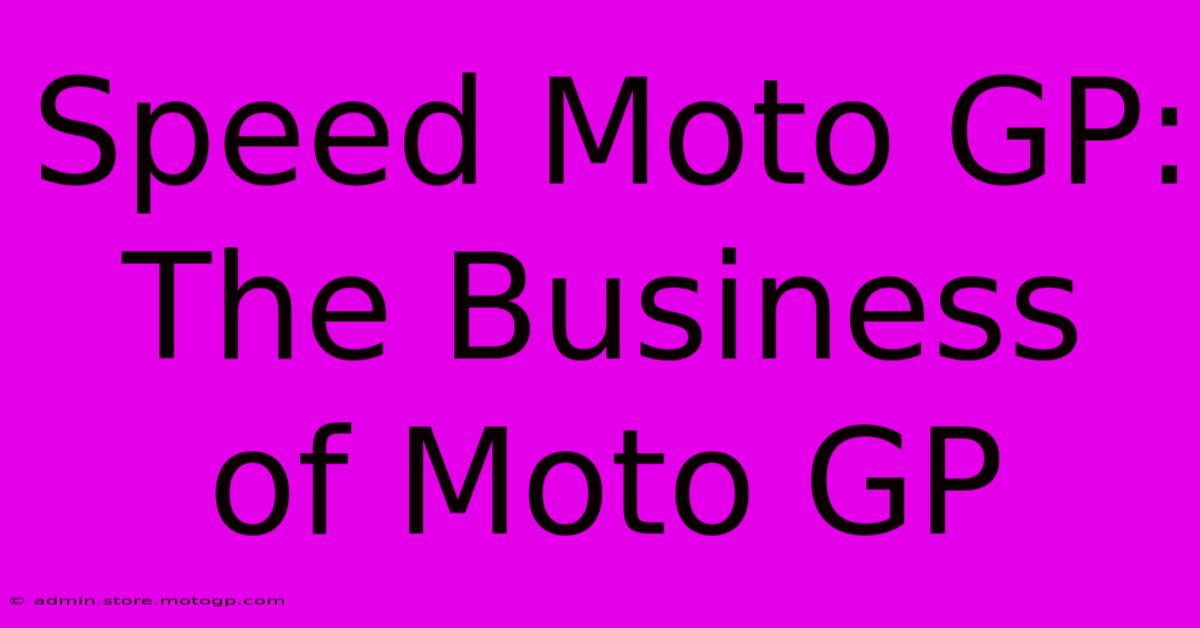Speed Moto GP: The Business Of Moto GP

Table of Contents
Speed Moto GP: The Business of Moto GP
MotoGP, the pinnacle of motorcycle racing, isn't just about speed and skill; it's a multi-million dollar global business. This article delves into the complex financial ecosystem fueling the sport, exploring the various revenue streams, sponsorship deals, and the significant investments required to compete at the highest level.
The Engines of Revenue: Where the Money Comes From
The roar of the engines isn't the only thing loud in MotoGP; the revenue streams are equally powerful. Several key components contribute to the substantial financial success of the sport:
1. Television Rights and Broadcasting:
This forms the cornerstone of MotoGP's financial power. Global television deals with networks in various countries generate enormous income. The captivating races, intense rivalries, and high-octane action draw millions of viewers worldwide, making it a highly sought-after broadcasting property. The exclusivity and global reach of these deals are crucial to the sport's financial health.
2. Sponsorship Deals:
Major corporations heavily invest in MotoGP sponsorships. Teams and riders showcase prominent logos on their bikes, leathers, and equipment, creating valuable brand visibility for sponsors. These deals vary widely in size and scope, with top teams securing multi-million dollar agreements. The global reach of the sport makes it an attractive platform for brands targeting a worldwide audience. Think of the prominent logos you see on racing bikes – that's a direct representation of significant financial investment.
3. Ticket Sales and Hospitality:
Grand Prix weekends are major events, drawing large crowds to race circuits globally. Ticket sales contribute significantly to the overall revenue, particularly at popular venues. Furthermore, premium hospitality packages, offering exclusive access and experiences, attract high-spending fans, adding another lucrative revenue stream.
4. Merchandising and Licensing:
MotoGP merchandise, including apparel, memorabilia, and branded products, generates substantial revenue. The licensing agreements for these products further expand the commercial reach of the sport, offering a steady stream of income. The popularity of the sport translates directly into high demand for officially licensed products.
The High Cost of Competition: Investments and Expenses
While MotoGP generates significant revenue, the cost of competing is equally substantial. Teams face significant expenses:
1. R&D and Technological Innovation:
Developing cutting-edge motorcycles requires substantial investment in research and development. The constant pursuit of performance enhancements, aerodynamic improvements, and technological advantages drives ongoing expenses.
2. Rider Salaries and Team Personnel:
Top riders command high salaries, reflecting their skills and contributions to the teams' success. Additionally, teams employ large numbers of engineers, mechanics, and support staff, all contributing to significant labor costs.
3. Travel and Logistics:
The global nature of the championship necessitates extensive travel and logistical arrangements. Transporting equipment, personnel, and support infrastructure across continents adds significantly to the overall cost.
4. Circuit Fees and Operational Costs:
Teams incur fees for track access, logistical support, and various operational expenses at each Grand Prix venue. These costs accumulate throughout the season, adding to the considerable financial burden.
The Future of MotoGP's Business Model: Challenges and Opportunities
The business of MotoGP is constantly evolving. The sport faces challenges such as maintaining its competitive edge in the ever-changing media landscape, securing sustainable sponsorship deals, and managing escalating costs. However, opportunities abound with growing global fan engagement through digital platforms and the potential for expansion into new markets.
In Conclusion:
MotoGP is a high-stakes, high-reward business. Understanding the intricate interplay of revenue streams, investments, and ongoing costs is crucial to appreciating the magnitude of this global sporting enterprise. The sport's financial success relies on a dynamic balance between securing substantial revenue and managing the immense costs associated with competing at the highest level of motorcycle racing.

Thank you for visiting our website wich cover about Speed Moto GP: The Business Of Moto GP. We hope the information provided has been useful to you. Feel free to contact us if you have any questions or need further assistance. See you next time and dont miss to bookmark.
Featured Posts
-
Grand Prix Red Bull The Undisputed Kings Of Speed
Feb 20, 2025
-
F1 Starting Grid The Most Crucial 60 Seconds Of The Race
Feb 20, 2025
-
Cota Track Day A Day To Remember
Feb 20, 2025
-
The Art Of The Perfect F1 Starting Grid
Feb 20, 2025
-
Cota Where Passion Meets Performance
Feb 20, 2025
